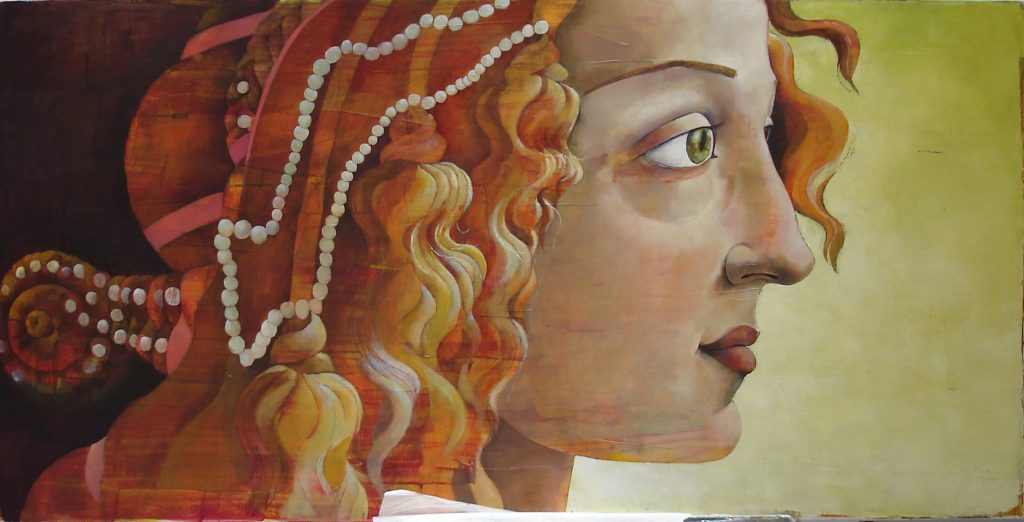- 18e editie Art Laren
- 14 – 16 juni 2013
- Dagelijks: 11:00 – 18:00 uur
- www.artlaren.nl

Hieronder staat een overzicht.


Sandro Botticelli, Ritratto ideale Simonetta Vespucci. 1480c.
During 2012, The Florentine and the city of Florence are celebrating the sesquicentennial of Amerigo Vespucci’s death. But what of the famed woman who also carried this last name?
In the middle of the sixteenth century in Florence, a group of scholars, philosophers and artists-actors in the extraordinary cultural scene of Lorenzo 'il Magnifico’ de’ Medici-attempted, with words and images, to define a model of feminine beauty. Simonetta Cattaneo Vespucci, a real, living woman, if not for long, seemed to incarnate this beauty in the eyes of the city. After her premature death, this beauty entered the realm of myth.
In the decades leading up to this moment, certain 'model women’ from Florentine high society were admired for their refined balance of opposites: beauty and modesty, attraction for others but beyond reproach, worldliness and piety, strength and delicateness. In the Laurentian school of thought, in the 1470s and 1480s, another female type, the 'nymph,’ was also highly exalted in poetry, art and society. This ethereal creature’s earthly beauty was a sign of her virtue, a concept inspired by Neoplatonic philosophy that channelled amorous tension towards a superior, civilizing and spiritual force.
Simonetta Cattaneo Vespucci, also known as La Bella Simonetta, was a living nymph who also possessed those exceptional qualities that made her an object of admiration that was characteristic of her time. Nonetheless, her biography does little to support her fame, first in life, and then in death.
Born around 1453 to Gaspare Cattaneo and Cattochia Spinola de Candia, either in Portovenere or Genoa, she and her family were exiled to Piombino, where it is believed that her marriage to the well-established Florentine Marco Vespucci was arranged. When, in 1469, the 16-year-old bride moved to Florence, she did not go unnoticed. Giuliano de’ Medici dedicated a joust to her in piazza Santa Croce a few years later, in January 1475. This spectacular event, described by contemporary sources, celebrated a military alliance of Florence, Milan and Venice. For the occasion, Agnolo Poliziano started his incomplete but very famous poem, ‘Le Stanze,’ in which the role of Giuliano in the military show finds a parallel in the fictional story of a hunting expedition. In the story, Cupid is angry because Iulo (a classicized name for Giuliano) is indifferent to love, so he transforms a doe into a nymph.
At this point in the story, Botticelli and Simonetta seem to cross paths. For Giuliano de’ Medici’s processional banner, Botticelli painted Minerva in arms, with the motto La sans par, amongst olive branches and flames. Minerva looks at the sun, while little Cupid is bound, his weapons broken. This image uses antique myth to rationalize modern Virtue: Minerva’s strength and eloquence wins over the disorder of Love. Although this image is lost and there are no drawings for or after it, two extant images are usually associated with Botticelli’s lost one. These are a drawing of Minerva in the Uffizi collection that was later used for a tapestry, and the figure of a woman in an intarsia door in the Palazzo Ducale of Urbino (the authorship of Botticelli here is contested). The blonde woman, whose harmonious forms can clearly be seen through her nymph-like dress, is believed to be inspired by Simonetta Vespucci, whom Botticelli would have drawn for the first time at the joust dedicated to her, and whose face is believed to be the inspiration for many of his female figures, including the Venus in the famous painting in the Uffizi, as well as women in paintings now in Frankfurt and Berlin. The Venus was, at this time, considered the supreme paradigm of natural beauty because the only decorative element added to her nude figure is a ribbon to contain, only in part, her long hair.
The very accurate representation of the hair of the goddess born from the sea and pushed to land by Aura and Zephyr-thick, windblown and highlighted with gold-must be a homage to Leon Battista Alberti, the great art theorist, who, two generations earlier, wrote, 'I am delighted to see seven movements in hair, which is especially pleasing when part of it turns in spirals as if wishing to knot itself, waves in the air like flames, twines around itself like a serpent, while part rises here, part there’ (Della pittura, II 45).
Her sleek body with its particular proportions, her blonde hair and sweet face together embody the feminine ideal attributed to Simonetta in her lifetime, although we can in no way prove that she modelled for Botticelli, either for the Venus or for the many other beautiful Madonnas in which we believe we see the unfortunate Ligurian beauty.
Having been protagonist in a brief but splendid season of Florentine public and private life, Simonetta died of consumption in 1476 amidst admiration and sadness, to the point that her coffin was paraded around the city to show the fragile nymph, real figure of urban myth, cut down in the springtime of her life. The legend of Simonetta, much fed by the Medici, was further enhanced at the death of Giuliano-Iulo, killed in the Pazzi Conspiracy of 1478.
Simonetta is commemorated in a posthumous portrait by another Florentine artist, Piero di Cosimo, located in the Museo Condo at Chantilly. The inscription 'SIMONETTA IANVENSIS VESPUCCIA’ parallels the early death by respiratory disease of our heroine with Cleopatra, pictured here against an open landscape, who awaits death by poison by the serpent wrapped around her neck and biting her breast.
The myth of La Bella Simonetta proved so resistant, through posthumous incarnations in Botticelli and others, that in the nineteenth century it was revisited by the Pre-Raphaelite circle of painters and contributed to the passionate interest of this period in Renaissance painting.